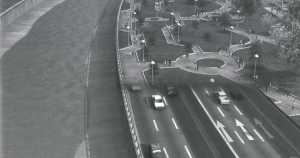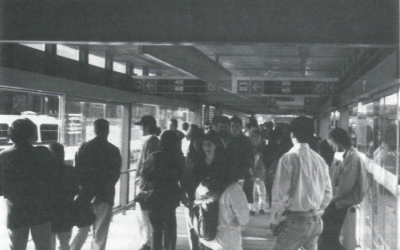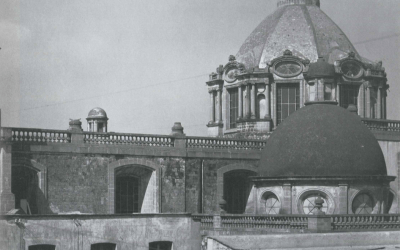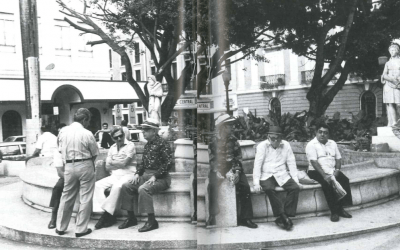The Tough Road to a Living City

“Costanera Norte” was envisioned as the first of a series of toll roads. Photo by Pablo Allard.
Latin American cities today are forging civic movements concerned about large-scale urban projects. In Chile, as in many other Latin American countries, participation in urban and environmental matters was largely ignored until recently.
Triggered by increased democratization, economic growth, globalization trends, environmental and social requirements for international trade agreements, and political activism, Latin American urban citizens are speaking out. They also reflect the growing worldwide public participation and environmental legislation that have spawned a change in civic attitudes towards large scale projects.
Like their outspoken counterparts in the United States in the late 1960s through the 1970s, Chilean civic activists are challenging highway construction.
Towards the end of 1995, residents in Santiago communities around the proposed urban highway began whispering that planning authorities were once again discussing the project—dormant for more than forty years. The road layout, by the time it was originally drafted, had been partial and unclear. As years went by, planning authorities completely ignored the old plans and allowed the consolidation of residential and informal settlements along the land corridor reserved for the highway’s right of way. Once rumors became official press releases, the “East-West System,” better known as “Costanera Norte Highway,” began to be developed as part of the national roadways concessions program. The Chilean government had developed and successfully implemented this program as a mixed public and private model for infrastructure provisions for non-urban highways since the early ’90s. “Costanera Norte” was to be the first of a new system of urban toll roads to be developed within this concession scheme in Santiago, and the government stakes were high in the matter.
Costanera Norte is a thirty-kilometer long privatized urban highway planned by the Chilean Ministry of Public Works MOP to increase mobility within the metropolitan region and to cope with the escalating congestion problems experienced in Santiago. The projected road would inevitably bisect the city from east to west along the northern banks of the Mapocho River, running from the wealthier suburbs of the city to the poor western settlements near Santiago’s international airport. On its projected track, the road will cross more than eleven municipalities and some of the most consolidated areas of downtown Santiago. These central areas are the most sensitive to negative disruption effects given the lack of space for the road and the imminent need for expropriations, destruction and spatial segregation created by a restricted access highway. The project promoter, Richard Lagos, then Minister or Public Works and current president of Chile, saw the highway as a key component of the integrated system of toll roads for the city. He believed citizens would rally behind the highway because of associated economic benefits. However, several groups expressed concern over the costs of the road, the environmental and urban impact of its location, as well as the failure to consider less disruptive, alternative projects. The government insisted on carrying out the project against all odds. Given the political and strategic importance of the project, it minimized citizen participation, an attitude that fueled fierce opposition and debate in the media and even in court. In just a matter of months, in reaction to the secrecy of the government’s plans for the road, the organization “Coordinadora No a la Costanera Norte” was created by a group of residents from the area. Over time, this organization became the most visible and powerful local group against the project—a vibrant example of the emerging civic responsiveness in Chile.
The members of the “Coordinadora” were mostly acting individually or in small groups, and so they soon realized the limited impact of their actions against the Ministry of Public Works (MOP). MOP was used to building roads in a unilateral fashion, ignoring what anyone had to say about its work, an attitude that triggered friction within the government itself. The Ministry of Housing and Urbanism, with its plans for limiting urban sprawl in the region, was particularly concerned. Within this context, several neighborhood groups, professional organizations, institutions, business groups, and environmentalists joined forces in the fight against the project. When taken to this extent, one might find various similarities between these groups and the American anti-highway movements and NIMBYs or “Not In My Back Yard” groups that reacted to highway building in the late sixties and early seventies. But in the case of the Chilean movement, the particularities of the group and the context in which it developed makes it a much more complex case study.
In order to understand the novelty of such a reaction, we must realize that during the Pinochet military regime (1973-1989), most social organizations such as advocacy groups, labor unions, NGO’s, and civic activists were banned, eliminating a long-standing tradition of social participation in Chilean politics. Despite the political prosecution, most of these groups enjoyed strong support from international organizations. Also, the technical and professional level of their members was remarkable, and their contribution to causes such as human rights and political reform were of paramount importance. After the return to democracy, most of these experts and activists became involved in the new government, and international support went directly to governmental initiatives. This shift in attention undermined the performance of many NGOs and civil organizations, questioning their role in the new democratic society. The case of Costanera Norte is clearly the best example of the resurrection of active civil involvement and community organization with respect to urban matters in Chile, a phenomenon that even the new democratic government never expected.
It started with the joint effort of two “juntas de vecinos,” the Chilean equivalent to school districts, and rapidly grew by incorporating several business groups, environmental activists, and the strong Committee for the Defense of the Santiago Metropolitan Park, a mountain park in the middle of the city whose hill steps were to be severed by the six-lane toll road. In a matter of months, the “Coordinadora No a la Costanera Norte” became a coalition of more than 25 community organizations representing about 50,000 citizens. The novelty of this case, at least in Chilean history, is the fact that the coalition included for the first time a variety of actors and interests that bridged historical divisions such as political interests and both social and economic status. Chile is still a country where power structures are socially determined; therefore, the fact of having “pobladores” or informal settlers sitting at the same table with rich homeowners, businessmen, and informal street merchants, was completely unprecedented. One of their first actions was to meet with authorities from the MOP and the Municipality of Providencia. This upper-middle class residential and commercial area of the city was in the heart of the impending disruption; the commercial area of Bellavista and the residential neighborhood of Pedro de Valdivia Norte would be especially affected, so its citizens set out to find a way to stop the project and revise the government plans. Three months after the meeting, and knowing that the project was definitively moving forward, the Coordinadora decided to sue the MOP.
Civic groups needed to develop strategies based on lessons learned from past conflicts. As recently as 1992, citizens failed to successfully oppose subway line 5, a MOP transit viaduct built without consideration of its urban impact. The coalition developed a strategy based on:
1. The experience from other ongoing conflicts at the time, mostly related to a major gas pipeline crossing the Andes and several forestry- and mining-related disputes.
2. Networking with international groups involved in anti-highway disputes in Toronto, Canada, the United States, and Europe.
3. Identifying and engaging renowned experts and academicians with the expertise in transportation, planning, urban design, and sustainability in order to reinforce the group’s knowledge base and arguments.
4. A detailed study of the concession and bidding process, in which they identified key moments where their action could stop the project such as the environmental impact assessment, authority decisions near electoral periods, and litigation in particular moments of the bidding that could deter the entire process.
In February 1996, the “Coordinadora” presented an alternative alignment proposing the construction of a tunneled highway in order to protect the hillsides of Mount San Cristobal, the city’s Metropolitan Park. The alternative alignment was accompanied by a new lawsuit against the current project that was almost immediately rejected by the courts. Soon after, the Coordinadora started a signature campaign and called for an open town council as a consequence of the council discussion. Afterwards, the Coordinadora established that it did not oppose the project itself but rather its projected path through a residential area. The group then began a campaign strategy that included constant litigation and legal pressure against the project and its supporters, thereby forcing the project to go through the SEIA, the environmental Impact assessment process recently incorporated into the 1994 Environmental Law. When the Ministry of Public Works decided to submit the project to the Environmental Impact Study, the authorities were not expecting the level of controversy that this process would cause.
Group experts were actively involved in the few opportunities opened for participation within the SEIA process. Citizenship involvement escalated. They organized rallies and public manifestations. They applied political pressure on local representatives and officers; they conducted an aggressive communications campaign intended to discourage foreign investors to participate in the bid. They worked on getting ample media coverage of all of the group’s actions. The SEIA process determined that MOP had to make radical changes in the project to reduce and mitigate environmental damage. These changes would make it too expensive for private interest to participate in the bidding process for the concession. Independent of the impact of the changes mandated by SEIA, the project went up for bid several times without any success. Despite the early opposition and defiant stand of the Coordinadora, the MOP started a massive press campaign aimed to inform the general public about the benefits of the project, organizing meetings with the eight directly involved municipalities, as well as county councils and neighborhood associations. They promised amazing urban improvement programs if they endorsed the project.
Pressured by the timing and its commitment to the urban highway program, MOP decided in December 1998 to call for a definitive bid. This bid failed and was later declared void since it had only one offer submitted which had not complied with the requirements for the bid. The main reasons for the failure given by the reading private capitalists were that either the project was extremely risky in financial terms or it was not satisfying enough with regards to their expected returns from it. This failure was a tough one for both the MOP and the government because of the extensive negative publicity. The citizens of the “Coordinadora No a la Costanera Norte” celebrated their triumph and made public their satisfaction with the failure of the bid. At that time, municipal authorities expressed their concerns about the future of the varied accords and protocols signed with the MOP.
Just four months later, the MOP once again revived the Costanera Norte, with the explicit support from the government and a new alignment that partially reduced neighborhood disruption. The bidding process was reactivated with new technical and economic conditions. New dates for the opening of both technical and economic bids was set towards the end of that year. On December 12, 1999 and after more than five years of delays and controversy, the government awarded the bid to a consortium formed by an Italian corporation and local construction companies as the new concessionaires for the Costanera Norte project. Construction started on September 2001 and is planned to be in full use by March 2004, giving the concessionary 30 years to operate the toll road before transferring it to the government according to the bidding bases. Meanwhile, former Public Works Minister and one of the key supporters of the project, Ricardo Lagos, was elected President of Chile.
The surprising result of the bid and the continued disruptive nature of the alignment came as a defeat to the group. Likewise, the citizen coalition’s leverage began to fade away as time passed without any news from MOP or the concessionary regarding the details of the project. That silence ended in January 2001 when authorities announced the possibility of a new alignment that would be different from all other previously discussed options and would avoid disruption of the two main contested areas–Mount San Cristobal and the historic district of Bellavista. The new alignment would run a tunnel along and under the riverbanks, presenting a creative and risky solution that reduced most of the impact on nearby neighborhoods and took into account the group’s main concerns about its design. Realizing that most of their claims against the project were now obsolete and out of place, the defeated citizen coalition called an end to its fight and left its members the option to negotiate monetary compensations directly with the concessionary.
Despite the abrupt end of the conflict that gave birth to the organization, it maintained its functions. It began to focus on on the urban redevelopment and community participation advocacy at a regional scale, building on their long experience in the “battlefield” and recognition and financial support by international groups. The coalition decided to become an official non-governmental organization and changed its name to Ciudad Viva (Living City). The organization has participated actively in current debates around the 2003 transportation plan for Santiago as well as several other public initiatives related to urban development and the environment. Even the government and its former adversary, President Lagos, have recognized the value of the coalition, and so they have officially invited its representatives to participate on the board of a national urban reform taskforce. Along with their advocacy and policy-making activities, Ciudad Viva is currently working in training communities to defend their urban rights and to develop their own urban development plans.
Thus, what started as one of the most controversial urban conflicts of the previous decades in Chile ended up with a less disruptive road. Moreover, it paved the way for a renewed responsive civilian participation in urban policy making and development.
Pablo Allard, a 2001-02 DRCLAS Graduate Student Associate, directs the “Cities, Landscape and Environmental Studies” unit at the Pontificia Universidad Catolica de Chile School of Architecture in Santiago. As a PhD student at the Harvard Graduate School of Design (GSD), he is researching the subject of highway infrastructure in emerging countries and its impact on the urban realm. He holds a degree in architecture from the Pontificia Universidad Catolica de Chile and a GSD Master of Architecture and Urban Design ’99.
Related Articles
Bogotá: A City (Almost) Transformed
The sleek red bus zooms out of the station in northern Bogota, a futuristic symbol of an (almost) transformed city. Nearby, thousands of cyclists of all ages enjoy a sunny morning on Latin America’s largest bike-path network.
Editor’s Letter: Cityscapes
I have to confess. I fell passionately, madly, in love at first sight. I was standing on the edge of Bogotá’s National Park, breathing in the rain-washed air laden with the heavy fragrance of eucalyptus trees. I looked up towards the mountains over the red-tiled roofs. And then it happened.
Social Spaces in San Juan
My city, San Juan, is a social city. Its character and virtue are best illustrated and defined by the collective and individual memories of its people and those places where we go to spend time in idleness….




